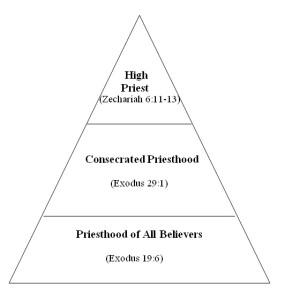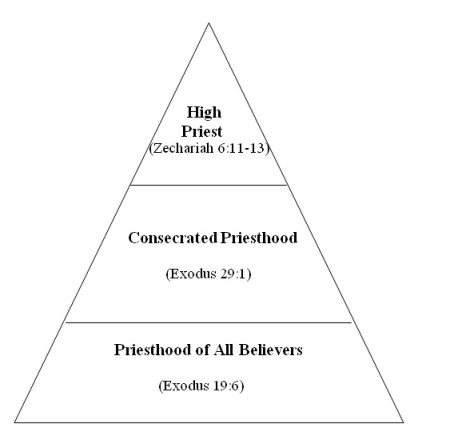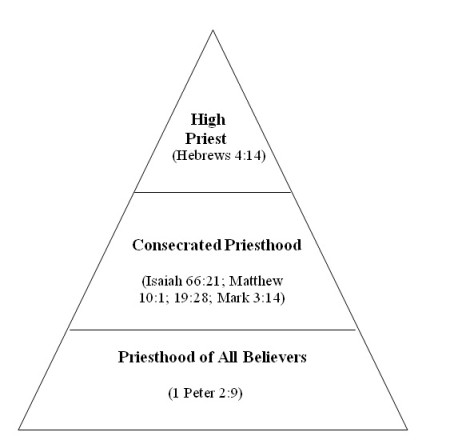I’m convinced that most Protestants haven’t thought through the question of the New Testament priesthood very much. For example, John MacArthur, a popular Evangelical Calvinist, in one of his many sermons against the Catholic Church argued:
“We don’t need any priests. Revelation 1: You are a kingdom of priests. We only need one high priest, and it’s not the Pope. We have one mediator, the man Christ Jesus. The veil is torn. We go right into the Holy of Holies. You are a priest and I am a priest unto God.”
Now, it may be that these claims all make sense together, but he’s essentially claiming:
- There’s no need for priests;
- There is a need for priests, but it’s limited to just Jesus, since any other priesthood would threaten His status as our One Mediator; and
- There is a need for priests, and it’s not limited, but open to all believers.
So given this, what’s the relationship between the believer and the rest of the world? Does the believer stand as an intercessor and a priest? MacArthur’s answer seems to be no, yes, no, yes. As a result, his arguments against the Catholic priesthood seem schizophrenic: we can’t have a priesthood because Christ is our One Mediator, and also, I’m a priest and so are you. In contrast, Scripture portrays the Church established, like Israel of old, with a High Priest (Christ), consecrated priests supporting Him (the clergy), and the laity as a priestly people, a Kingdom of priests.
In the Old Covenant, there was a three-tiered priesthood:
Here is the man whose name is the Branch, and he will branch out from his place and build the temple of the LORD. It is he who will build the temple of the LORD, and he will be clothed with majesty and will sit and rule on his throne. And he will be a priest on his throne. And there will be harmony between the two.’
This words apply much more fully to Christ, the Branch of David (Jeremiah 23:5; Jeremiah 33:15), whose very Body was the Temple (John 2:21). Obviously, this wasn’t obvious to the Jews at the time, but with the benefit of hindsight, it’s clear that Christ as Eternal High Priest has always been the plan.
Then Moses went up to God, and the LORD called to him from the mountain and said, “This is what you are to say to the descendants of Jacob and what you are to tell the people of Israel: ‘You yourselves have seen what I did to Egypt, and how I carried you on eagles’ wings and brought you to myself. Now if you obey me fully and keep my covenant, then out of all nations you will be my treasured possession. Although the whole earth is mine, you will be for me a kingdom of priests and a holy nation.’ These are the words you are to speak to the Israelites.”
The priesthood in the New Covenant is a fulfillment of, not an abolition of, the Old Covenant (Matthew 5:17). That is, everything in the Old Covenant existed for a reason, to prepare us for the New and more perfect Covenant in Christ (Hebrews 8:6):
A few remarks again:
(1) The High Priest: Even the term High Priest suggests that while Christ enjoys a unique Headship, He’s not the only Priest. And this is clearly His office, as Hebrews 9:11 tells us. The New Covenant is superior to the Old, in that Christ’s lineage is eternal, since He Himself is eternal. This is also hinted at in the Old Testament with Melchizedek (see Genesis 14:18-20), the King of Peace who Abraham seems to regard as Someone superior to himself, and who we now realize was Christ Himself. Hebrews 7:1-10 explains all of this prefigurement in beautiful detail. So, too, does Christ, when He applies Psalm 110 to Himself (Matthew 22:41-46).
(2) The Consecrated Priesthood: The New Covenant clearly has a Consecrated Priesthood made up of some, but not all, believers. The last chapter of Isaiah tells us so. In Isaiah 66:18-21, God speaks plainly of His entry into history in the Incarnation:
And I, because of what they have planned and done, am about to come and gather the people of all nations and languages, and they will come and see my glory.
I will set a sign among them, and I will send some of those who survive to the nations—to Tarshish, to the Libyans and Lydians (famous as archers), to Tubal and Greece, and to the distant islands that have not heard of my fame or seen my glory. They will proclaim my glory among the nations. And they will bring all your people, from all the nations, to my holy mountain in Jerusalem as an offering to the LORD—on horses, in chariots and wagons, and on mules and camels,” says the LORD. They will bring them, as the Israelites bring their grain offerings, to the temple of the LORD in ceremonially clean vessels. And I will select some of them also to be priests and Levites,” says the LORD.
At the time Isaiah is written, this is still a prophesy. It’s not any more. God did personally come down here, as He promised. He did unite all believers, Jews and Gentiles alike (John 10:16; Galatians 3:28). And He did select some of these believers to be the new Levites. Now, the Levites of old were descended by bloodline: one was born a Levite. Not in the New Covenant: God chooses them, and it includes Greeks as well as Jews. This, by the way, is the fulfillment of Numbers 18:19. The Levitical line is transformed into something more perfect, rather than abolished.
We see Christ selecting this consecrated priesthood beginning with the Twelve. Look at Mark 3:14-15. The KJV says:
And He ordained twelve, that they should be with Him, and that He might send them forth to preach, And to have power to heal sicknesses, and to cast out devils:
So these are individual men which Christ ordained for a special purpose. And not just any special purpose: the proclamation of the Gospel is a mark of the priesthood. Paul says he’s been comissioned with the “priestly duty of proclaiming the gospel of God” (Romans 15:16). While we’re all called to proclaim the Gospel in some sense, priests are called to it in a particular sense. That’s why Christ ordained the Twelve to preach; that’s why Paul calls it a priestly office; and that’s why Paul can’t even imagine someone preaching without being sent by Christ or the Church (Romans 10:15).
But let’s get back to the Twelve. Despite Christ’s countless followers, He chooses twelve to impart with special spiritual authority in Matthew 10:1 (which we also see in Mark 3:15). Most shockingly, look at Matthew 19:28, in which Christ promises thrones to the Twelve, and to share in the judgment of the world with Him. He does this again at the Last Supper, in Luke 22:28-30. Think about that for a moment: Christ, the eternal Judge of all Mankind, has chosen twelve mortal men to join Him eternally in judgment. The Twelve includes the Eleven saved Apostles, and Matthias. Look at Acts 1:12-26, and you’ll see a Church which recognizes the Apostleship as an office (and call it such in Acts 1:20, although you wouldn’t know it from the NIV). They don’t ask the people who would make the best Apostle, or who they’d want as a leader. Rather, a top-down decision is made through prayer.
In fact, in Acts 1:20, they refer to the office of Apostle as an episkopē, the same word used to describe the office of bishop elsewhere in the New Testament (Titus 3:1). So the bishops are seen as successors to the Apostles (although not the same as the Twelve) in the New Testament itself.
(3) The Priesthood of All Believers: Two passages primarily support this doctrine, both of which are clear parallels to Exodus 19:6. The first is Revelation 1:5-6, which I mentioned above. The second is 1 Peter 2:9,
But you are a chosen people, a royal priesthood, a holy nation, God’s special possession, that you may declare the praises of him who called you out of darkness into his wonderful light.
Peter is obviously referring to Exodus 19, since he’s using the three marks of true Israel: God’s treasured possession, His royal priesthood, and His holy nation. So the Church is the New Israel. Peter explains the sense in which we’re priests immediately before this, when he says (1 Peter 2:4-5):
As you come to him, the living Stone—rejected by humans but chosen by God and precious to him— you also, like living stones, are being built into a spiritual house to be a holy priesthood, offering spiritual sacrifices acceptable to God through Jesus Christ.
Peter, of all people, wouldn’t need reminding that this “holy priesthood” doesn’t erase the distinction between the laity and the Twelve. While the people are living stones, and Christ is in a unique way the living Stone, Peter himself is in somewhere in-between. Peter’s very name is testament to this fact (Matthew 16:18; John 1:42), and the readers of this epistle weren’t ignorant of this. Nor would they have thought that the lay priesthood abolished the consecrated priesthood, since they were intimately familiar with this distinction as Israelites.
In the Old Covenant, there was a high priest, assisted by the consecrated Levitical priesthood. They ministered to the Israelites who were themselves priests in a non-consecrated sense. The Israelites served as a priestly people, so that through their holy example, non-Israelites would want to follow the God of Israel. In this way, all the world would be blessed through Israel (Genesis 12:3).
In the New Covenant, we see the High Priest Jesus Christ. He’s willingly drawn a priesthood to Himself (as He promised He would in Isaiah) to help Him eternally, even though He needs no help. While we may balk at God’s decision to have mortal men participate in His plan, there’s no question that He chose to: Matthew 19:28 alone is testament to this. In addition to this consecrated priesthood, the laity are also priests in a special way. While we cannot offer the Sacrifice of the Eucharist, since that was left only to the consecrated priests (Luke 22:19; see also John 13:15-18), we can offer up “spiritual sacrifices” acceptable to God – the sort of sacrifice that the John MacArthurs of the world deny as necessary. Christ’s specially ordained ministers are our shepherds (Jeremiah 3:15-16; Acts 20:28), while we sheep are to shepherd non-believers into the Church by living holy lives.
What’s untenable is the idea that Christ created a three-tiered system in the Old Covenant (high priest, consecrated priests assisting the high priest, priestly people), created a three-tiered system in the New Covenant (Himself as High Priests, ordained priests assisting Him, priestly people), and then wanted that three-tiered system not to survive the Apostles. Certainly, this wasn’t the way the Apostles viewed it, or we wouldn’t see the parallel between Acts 1:20 and Titus 3:1.



Hi,
please help me understand how a priest was prepared to become a priest in the Old Testament from his childhood. For example, at the age of 6 he was ……. and so on.
thank you
I believe it is important to have a priesthood within the church it would be interesting to mention their is no mention of a person being a priest in the new testament of the bible people are often refered to as elders being appointed as bishops the roman catholic church claims to be the true church and that all other religions are false however i have studied the bible and nowhere does it mention about their being a papacy or their being a successor to saint peter all jesus christ said was peter upon this rock you will build my church he gave no mention of their being a successor to saint peter also catholics believe their is no need for temple worship this is strange as when jesus christ visited the temples in jerusalem he called these temples as the house of god so it is important to build temples as well as churches I am a mormon and in our religion we have both churches and temples to worship the main christian churches fell into apostacy the bible foretells their would be a fall jesus christ and god then established the true church through joseph smith the prophet of god when joseph smith came face to face with jesus christ and god just as moses also came face to face with god.
Thank you Joe Heschmeyer for this post. I just would like to add some corresponding references from old testament with what you have already mentioned.
For John 13:5, references are Exodus 29:4, 30:17-21 and 40:12.
For John 13:8, reference : Numbers 18:20
Thank you again
Viola
Timothy not Titus?